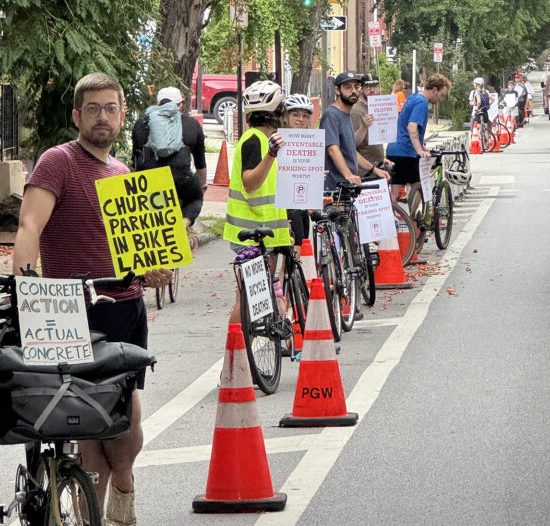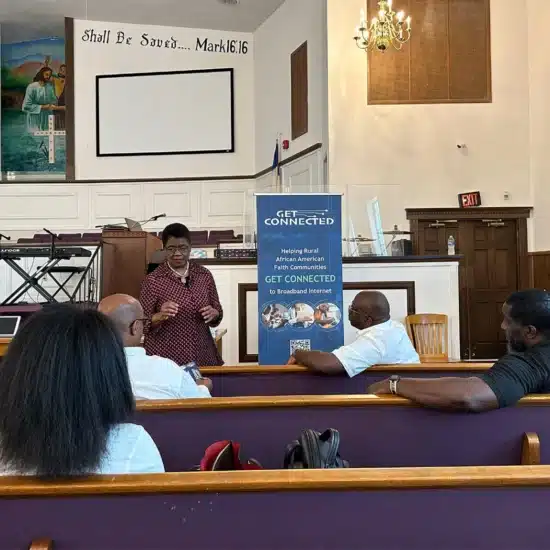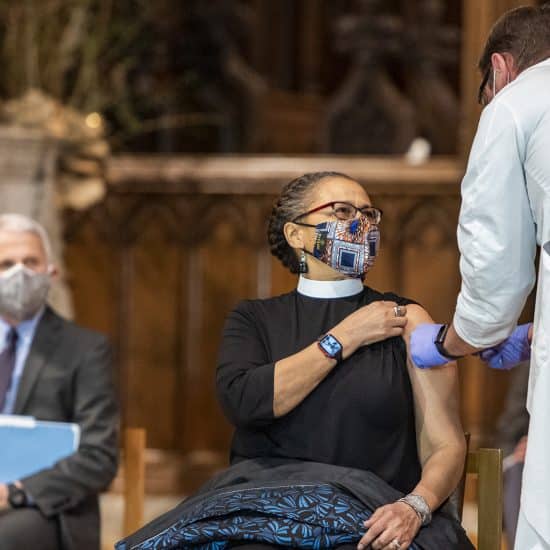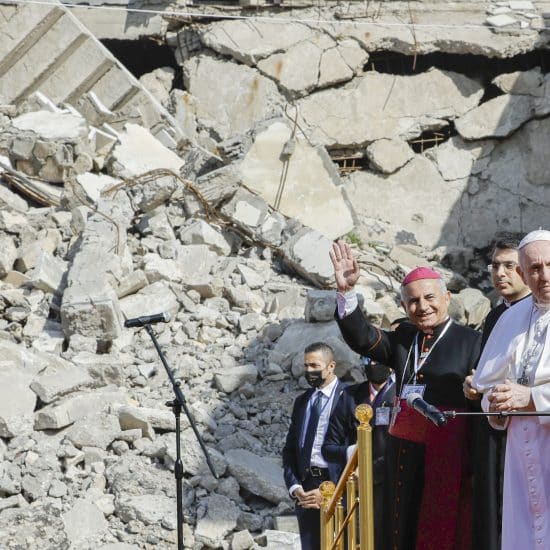Eighty percent of success is showing up, film director Woody Allen once said. Increasing numbers of downtown churches have discovered a high percentage of successful ministry is staying put.
Committed to "blooming where they're planted," these congregations have developed vibrant ministry to their in-town communities. And remaining there is integral to their identity and the way they engage God's mission.
Downtown churches are an idea whose time has come, some observe. The revitalization of America's urban cores and the migration of people to renovated downtown apartments and condominiums have positioned these congregations in some of the country's most energetic neighborhoods.
• Third Baptist Church sits in the heart of St. Louis's Grand Center arts and entertainment neighborhood, near the city's Loft District.
• First Baptist Church of Clarendon, in highly-urbanized Arlington, Va., is a few miles from the White House and surrounded by thriving restaurants and galleries, across the street from a busy subway station.
• A nearby light-rail station also energizes Houston's South Main Baptist Church, adjacent to Midtown's museums, universities and sprawling medical center.
• Oklahoma City's First Baptist Church, which moved in the early 20th century to its current location because noise from adjacent trolley tracks was disrupting worship, now finds itself on a proposed light-rail line in the city's booming center.
• Restaurants and renovated housing surround First Baptist churches in historic in-town districts of Richmond, Va., and Wilmington, N.C.
• First Baptist Church in Knoxville, Tenn., perches above the Tennessee River as it flows through downtown. The University of Tennessee is less than a mile away.
"We're at the center of the most vibrant community in the world," Pastor Steve Wells from South Main Baptist said of his Houston congregation. "We're surrounded by incredibly bright people who are making a difference in the way the world works."
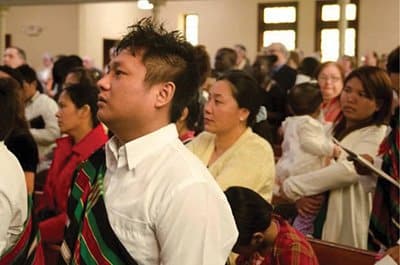
Worshippers participate in one of the five congregations that gather at First Baptist Church in Oklahoma City. (PHOTO/Courtesy of First Baptist Church, Oklahoma City)
|
It wasn't always so. For two decades beginning in the 1960s, white flight, racial tensions and deteriorating central cities left many downtown churches isolated and their members living in distant suburbs. Congregations that remained often faced dwindling attendance.
But during that stagnant period, many of these churches chose to stay where they were.
"Staying put while everyone else is leaving takes courage," said Warren Hoffman, pastor of Third Baptist. "There was a time in the 1970s when Third Baptist was the only building not boarded up for a two-block radius."
And despite recent downtown renaissances, the challenges of urban life remain—overused infrastructure, poor public schools and homeless populations.
The slogan adopted by Hoffman's congregation—"Third Baptist Church Is in the City for Good"—is a strong faith statement in the face of past and present challenging circumstances.
Intentionally urban
Intentionality about remaining downtown is a common strand in these churches' stories. In almost every case, each congregation seriously considered—sometime more than once—a move to the suburbs, and each determined to stay in its setting.
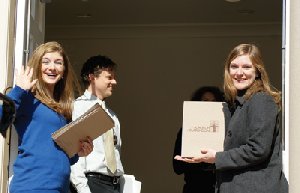
Greeters welcome visitors to the Church at Clarendon (upper left), in the heart of one of the most densely packed neighborhoods in Washington, D.C. (PHOTO/Courtesy of Church at Clarendon)
|
In 2000, for instance, First Baptist Church of Clarendon "was in deep decline and struggling with a vision," Interim Senior Pastor David Perdue said.
"The church had other options" than staying, Perdue said. "At one point, the property was valued at $13 million. We could have moved to the suburbs. But we wanted to do something for the community."
First Baptist Church in Knoxville, Tenn., decided in 1975 to remain at its location, Pastor Bill Shiell said.
"The church had moved from downtown to uptown and built its current sanctuary in 1924," said Shiell, a graduate of Baylor University's Truett Theological Seminary. "They were not up for another move."
Tom Ogburn, pastor of First Baptist in Oklahoma City, said the congregation voted in the 1980s and again in 2003 to remain where they had been since 1912.
"For us, that decision wasn't a death sentence. It was a gift of life," Ogburn said. "It's not an urban challenge; it's a call from God. This is where God has placed us."
Unquestionably, heritage and valued memories were factors in those decisions to stay. Many downtown churches are more than 100 years old—some considerably older than that—and heritage can be a strong motivation for remaining in cherished locations, said George Bullard, strategic coordinator for the Columbia Partnership, a church consultancy.
"They have a historic mantle of leadership and are justifiably proud of their heritage," Bullard said.
Their vibrant past often makes them historically significant to their denominations as well, he added, and their sanctuaries may be closely associated with key denominational figures, such as Theodore F. Adams at First Baptist in Richmond or Herschel Hobbs at First Baptist in Oklahoma City.
But alongside—and sometimes trumping—reverence for the past is a clear sense of calling to city centers, these pastors note, and a passion to engage their communities in the 21st century.
"This is where God has called us to be," Wells said regarding South Main Baptist in Houston.
Range of ministries
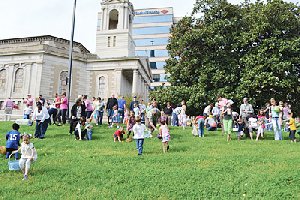
First Baptist Church in Knoxville, Tenn., perched on a downtown hill above the Tennessee River and at its current location since 1924, hosted that city\\\'s only downtown Easter egg hunt on March 31. (PHOTO/Courtesy of First Baptist Church, Knoxville)
|
The churches' sense of call to their community has spawned a breathtaking array of ministries to the marginalized, to refugees, to commuters in downtown office blocks and to nearby apartment dwellers.
• Matching the church's strengths to its neighbors needs was key to developing ministries at First Baptist in Knoxville.
"Most people ask: 'What do they need? What are the problems? What are the solutions?'" Shiell said. "We have tried to ask, 'What are our strengths, and where do they match with a need?'"
The result included The Bridge, a mid-week Bible study for the business community that has developed features of executive coaching for "businesses and executives who want to take the next step in their faith at work"; a mentoring partnership—KidsHope USA—with children at a nearby elementary school; and the nonprofit Heart of Knoxville, which aims to partner with businesses, corporations, foundations and individuals to expand the church's resources for ministry. Last year, Heart of Knoxville served 600 homeless and working poor families, said Shiell. This year it hopes to expand the church's new food co-op.
"We're in the middle of an initiative now called 'Seek the Peace of Knoxville' that will be both a revival and an invitation to relocate downtown," Shiell said.
• In Oklahoma City, First Baptist took a cue from its past to guide ministry in the present. In its century of existence, the church had started 63 new congregations and been actively involved with refugees.
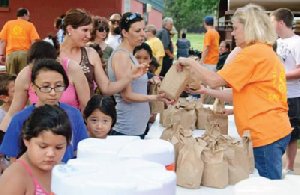
Members of First Baptist Church in Oklahoma City distribute food as part of its ministry to the downtown community. (PHOTO/Courtesy of First Baptist Church, Oklahoma City)
|
"Part of our task has been to call the church back to those places where God has called us in the past and find similar opportunities today," Ogburn said.
Currently, four congregations in addition to the original one worship in First Baptist's facilities— United Myanmar Baptist Church; New Life Baptist Church, a Hispanic congregation; Sudanese Christian Fellowship; and Convergence Church, an emergent community of faith.
A sixth congregation—All African Baptist Church—is being developed in a partnership with the Ghana Baptist Convention, the national Cooperative Baptist Fellowship and its Oklahoma affiliate, and NorthHaven Church in Norman, Okla., a congregation affiliated with the Baptist General Convention of Texas.
In the 1960s, as Oklahoma City's downtown deteriorated, First Baptist created Good Shepherd Ministries of Oklahoma to distribute food and clothing. It began offering medical services in 1975 and dental treatment in 1980. Seven years ago, Good Shepherd became an independent nonprofit organization, while retaining close ties to First Baptist. Ogburn said the group soon will hear a response to its application for a significant grant from a local foundation which will permit the facility's expansion and the medical clinic to be operated full time.
• In addition to ministry with thousands of homeless men and women on Houston streets, South Main set its sights on the Texas Medical Center and its 50 member institutions, about two miles south of the church.
"We own 20 apartments and coordinate another 100 apartments for people who come to the center for long-term medical care," Wells said. Church members clean the units and assist the families living there temporarily.
The church also discovered an unexpected need among the homeless, he said. When their few possessions were stolen—not uncommon for those living on the streets—they often lost documents necessary to get a job. The church helps them replace the necessary birth certificates and identification cards.
Facilities as God's gifts
Undergirding these churches' ministries are sizable and often architecturally elaborate buildings. Most were built decades ago and require extensive maintenance. But instead of a drain on resources, the churches see their building as gifts which offer unforeseen possibilities.
"God has gifted us with a 180,000-square-foot building," Ogburn said. "The building is a gift from God, but we had to choose to see it that way. You can choose to let a building weigh you down or make it a gift of God."
In Knoxville, First Baptist's 1924 blend of English Renaissance and Romanesque architecture "is what God has given us, and it's gorgeous," said Shiell. "There's nothing like it."
"Having a large building that has generous and big spaces is a tremendous benefit," Hoffman said of Third Baptist's streamlined Gothic building with a distinctive retro neon sign. At 115,000 square feet, Third Baptist "offers potential for revenue as we lease some spaces, including our parking lot, which is a premium value in the city center."
"The sanctuary is breathtaking," he added. "They just don't build worship centers like this anymore. It is in demand as a concert venue, and congregational worship and music is fantastic due to the acoustics."
Those facilities come with a cost, but it's one church leaders agreed they're willing to pay.
"The generation that didn't build the building and care for it doesn't share in the maintenance and upkeep," said Shiell. "So, we're working on developing an endowment for facilities to bridge that gap."
Despite the expense, Wells said of South Main Baptist, "We have a remarkable space, and we can honor God and do kingdom work that we couldn't do without it."
It's that kingdom work which brings the greatest satisfaction, said Ogburn.
"This is the most fun I've ever had in church," he said. "I can't imagine being anywhere else."

